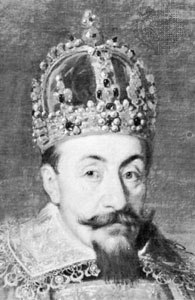Muscovy Crown on:
[Wikipedia]
[Google]
[Amazon]
 The so-called Muscovy Crown ( pl, Korona moskiewska) was a part of the
The so-called Muscovy Crown ( pl, Korona moskiewska) was a part of the
 The so-called Muscovy Crown ( pl, Korona moskiewska) was a part of the
The so-called Muscovy Crown ( pl, Korona moskiewska) was a part of the Polish Crown Jewels
The only surviving original piece of the Polish Crown Jewels ( pl, Polskie Klejnoty Koronne) from the time of the Piast dynasty is the ceremonial sword – Szczerbiec. It is currently on display along with other preserved royal items at the W ...
. It was made in about 1610 in anticipation of Prince Władysław Vasa's coronation as Tsar of Russia
This is a list of all reigning monarchs in the history of Russia. It includes the princes of medieval Rus′ state (both centralised, known as Kievan Rus′ and feudal, when the political center moved northeast to Vladimir and finally to Mos ...
, which was also known as Muscovy Muscovy is an alternative name for the Grand Duchy of Moscow (1263–1547) and the Tsardom of Russia (1547–1721). It may also refer to:
*Muscovy Company, an English trading company chartered in 1555
* Muscovy duck (''Cairina moschata'') and Domes ...
. Due to his father's opposition and a popular uprising in Russia, he never actually took the Russian throne, despite being elected by the Seven Boyars
The Seven Boyars (russian: link=no, Семибоярщина, the Russian term indicating "Rule of the Seven Boyars" or "the Deeds of the Seven Boyars") were a group of Russian nobles who deposed Tsar Vasily Shuisky on 17 July 1610 and, later that ...
. Nevertheless, until 1634 he used the title of Grand Duke of Muscovy.
History
The Muscovy Crown was the type of ''corona clausa'', made in the form of the rims covered with the globe and a cross on their intersection. It was decorated with precious stones includingsapphire
Sapphire is a precious gemstone, a variety of the mineral corundum, consisting of aluminium oxide () with trace amounts of elements such as iron, titanium, chromium, vanadium, or magnesium. The name sapphire is derived via the Latin "sa ...
s, emeralds, rubies
A ruby is a pinkish red to blood-red colored gemstone, a variety of the mineral corundum ( aluminium oxide). Ruby is one of the most popular traditional jewelry gems and is very durable. Other varieties of gem-quality corundum are called sap ...
and pearls. In total there were 255 precious stones. The crown was bequeathed by King Władysław IV Vasa
Władysław IV Vasa; lt, Vladislovas Vaza; sv, Vladislav IV av Polen; rus, Владислав IV Ваза, r=Vladislav IV Vaza; la, Ladislaus IV Vasa or Ladislaus IV of Poland (9 June 1595 – 20 May 1648) was King of Poland, Grand Duke of ...
to the Polish–Lithuanian Commonwealth
The Polish–Lithuanian Commonwealth, formally known as the Kingdom of Poland and the Grand Duchy of Lithuania, and, after 1791, as the Commonwealth of Poland, was a bi- confederal state, sometimes called a federation, of Poland and Lithuania ru ...
, however, after the king's death in 1648, it was appropriated by King John II Casimir
John II Casimir ( pl, Jan II Kazimierz Waza; lt, Jonas Kazimieras Vaza; 22 March 1609 – 16 December 1672) was King of Poland and Grand Duke of Lithuania from 1648 until his abdication in 1668 as well as titular King of Sweden from 1648 ...
and bequeathed to the State Treasury in 1668. It was pawned lawlessly in 1700 by King Augustus II the Strong
Augustus II; german: August der Starke; lt, Augustas II; in Saxony also known as Frederick Augustus I – Friedrich August I (12 May 16701 February 1733), most commonly known as Augustus the Strong, was Elector of Saxony from 1694 as well as K ...
, and later appropriated by Frederick I of Prussia
Frederick I (german: Friedrich I.; 11 July 1657 – 25 February 1713), of the Hohenzollern dynasty, was (as Frederick III) Elector of Brandenburg (1688–1713) and Duke of Prussia in personal union (Brandenburg-Prussia). The latter function h ...
(part of so-called ''Pawn of the Rzeczpospolita
() is the official name of Poland and a traditional name for some of its predecessor states. It is a compound of "thing, matter" and "common", a calque of Latin ''rés pública'' ( "thing" + "public, common"), i.e. ''republic'', in Engli ...
'') as a result of German claiming to the outlays sustained during the Deluge
A deluge is a large downpour of rain, often a flood.
The Deluge refers to the flood narrative in the Biblical book of Genesis.
Deluge may also refer to:
History
*Deluge (history), the Swedish and Russian invasion of the Polish-Lithuanian Com ...
(the popular name for the Swedish invasion of Poland during the reign of King John II Casimir).
One of the gems from the crown became the property of Jan Kazimierz Krasiński, Grand Treasurer of the Crown. It was in the possession of the Krasiński family till the 19th century. Later it was given to Tsar Nicholas I of Russia
, house = Romanov-Holstein-Gottorp
, father = Paul I of Russia
, mother = Maria Feodorovna (Sophie Dorothea of Württemberg)
, birth_date =
, birth_place = Gatchina Palace, Gatchina, Russian Empire
, death_date = ...
by Wincenty Krasiński and found its place in the collections of the Kremlin Armoury
The Kremlin Armoury,Officially called the "Armou/ory Chamber" but also known as the cannon yard, the "Armou/ory Palace", the "Moscow Armou/ory", the "Armou/ory Museum", and the "Moscow Armou/ory Museum" but different from the Kremlin Arsenal. ( ...
in Moscow.
References
Further reading
* Jerzy Lileyko. ''Regalia Polskie''. Warszawa 1987. * Janusz Miniewicz. ''Tajemnica polskich koron. Czy jest szansa ich odnalezienia?''. Nowy Sącz 2006. * Michał Rożek. ''Polskie koronacje i korony''. Kraków 1987.External links
{{Crowns 1610 works Individual crowns Polish crown jewels 1610 in Russia Frederick I of Prussia